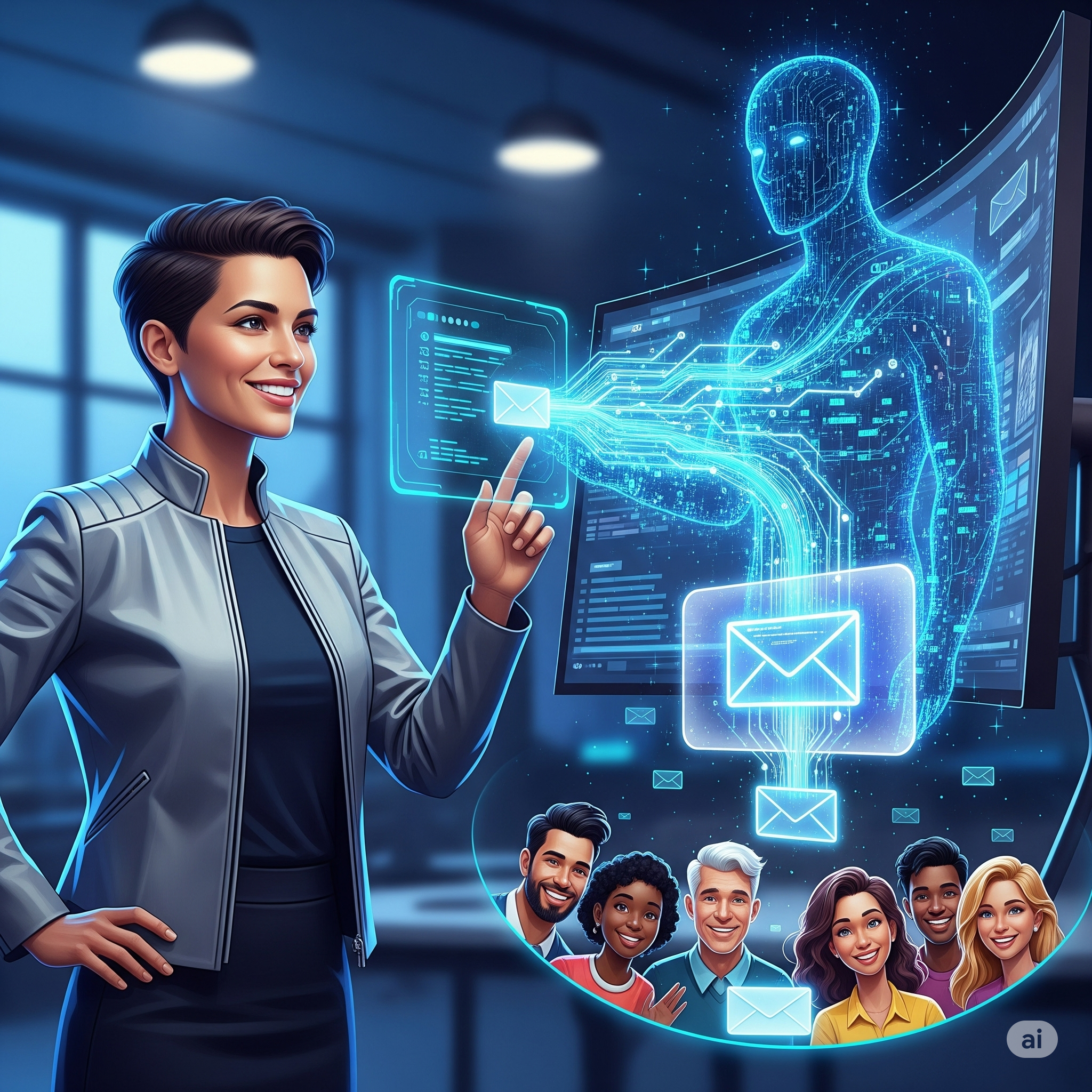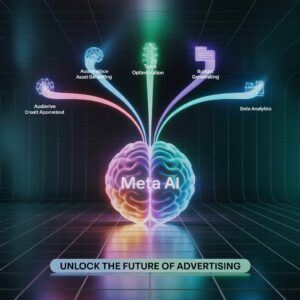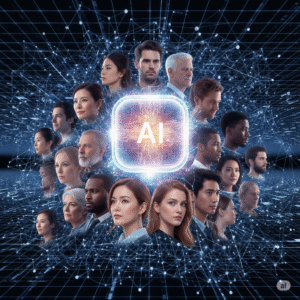Remember when email marketing was just about sending the same message to everyone on your list? Those days are long gone. Today, the email inbox is a crowded, personal space, and generic messages are instantly deleted. To truly stand out, you need to deliver something special, something that feels like it was written just for one person. That’s where AI in email marketing comes in.
Artificial intelligence isn’t a futuristic concept anymore; it’s the game-changer for modern marketing. We’re talking about tools that can analyze vast amounts of data, predict customer behavior, and even write compelling, personalized content. This isn’t just about automation; it’s about intelligent, data-driven decisions that elevate your entire strategy. So, how exactly is AI in email marketing reshaping the landscape in 2025? Let’s dive deep into the revolution.
The Power of Personalization with AI in Email Marketing
Think about the last email you opened and actually read. Chances are, it was hyper-relevant to you—maybe it was a special offer on a product you’d been Browse, or a personalized recommendation based on a past purchase. This level of personalization is the new standard, and it’s powered by AI in email marketing.
Instead of manually segmenting your audience into broad categories like “men aged 25-34,” AI algorithms can create dynamic micro-segments. These segments are based on hundreds of variables, from a customer’s Browse history and purchase patterns to their real-time engagement with previous emails. This granular approach allows for an unprecedented level of relevance, making every email feel like a one-on-one conversation.
Why is AI for Working Professionals!!
Crafting Content at Scale: The Role of AI in Email Marketing
One of the biggest challenges for marketers has always been creating high-quality, engaging content consistently. With artificial intelligence for email marketing strategies, that hurdle is now much lower. AI-powered tools can assist with every stage of the content creation process, from brainstorming ideas to writing the final copy.
For example, AI can generate multiple versions of a subject line and test them automatically to see which performs best. This kind of A/B testing, once a manual and time-consuming process, is now instantaneous and data-driven. Natural Language Processing (NLP) models can even analyze your brand’s voice and generate entire email bodies that are not only personalized but also consistent with your brand’s unique tone. This saves countless hours and frees up your creative team to focus on bigger, more strategic initiatives.
Case Study: A Retailer’s AI-Driven Success
A fast-growing e-commerce retailer, let’s call them “StyleHub,” was struggling with a low email click-through rate. Their generic weekly newsletter was getting lost in a sea of promotional emails. They decided to implement AI in email marketing to transform their approach.
StyleHub began using an AI-powered platform to analyze each customer’s past purchases and Browse behavior. When a customer, Jane, browsed a specific brand of shoes, the AI immediately triggered a personalized email. The email’s subject line, crafted by AI, was something like, “Jane, We Found a Pair of Sneakers Just For You.” Inside, the email featured the exact shoes she had viewed, along with several complementary products recommended by the AI. This campaign resulted in a 45% increase in click-through rates and a 20% boost in revenue from email marketing alone. This is a perfect example of how AI in email marketing can turn data into tangible results.
Predictive Analytics and Automation: The Core of AI in Email Marketing
The real magic of AI in email marketing lies in its ability to predict the future. Predictive analytics, a core component of AI, analyzes historical data to forecast future customer behavior. This allows marketers to anticipate needs and send the right message at the perfect moment.
- Optimal Send Times: AI can analyze a subscriber’s historical open times to pinpoint the exact moment they are most likely to engage with an email. Instead of sending a batch email at 9 AM to everyone, the AI sends each email at the individual’s optimal time, significantly increasing open rates.
- Churn Prediction: AI models can identify customers who are likely to disengage or unsubscribe. This allows marketers to send targeted re-engagement campaigns to these individuals before they’re lost forever, maximizing customer lifetime value.
- Predictive Product Recommendations: Based on a customer’s past behavior and the behavior of similar customers, AI can predict which products they will be interested in next. This is a significant step up from simple “people who bought this also bought…” recommendations.
This intelligence-driven automation allows for a truly hands-off approach, where the system continuously learns and optimizes your campaigns for you. It’s a powerful combination of efficiency and effectiveness.
Practical AI Tools for Your Email Marketing Strategies
You might be thinking this all sounds great, but how do you actually start? The good news is that powerful AI in email marketing tools are more accessible than ever. Here are a few that can help you get started:
- ChatGPT: While not a dedicated email marketing tool, large language models like ChatGPT can be an invaluable asset for content creation. Use it to brainstorm subject lines, draft compelling email copy, or even create outlines for an entire campaign series. It’s a great starting point for leveraging artificial intelligence for email marketing strategies.
- HubSpot: A marketing giant with a suite of AI-powered features. HubSpot’s Campaign Assistant uses AI to help you write and optimize email copy, suggest subject lines, and provide data-driven insights into your campaigns. Their platform seamlessly integrates AI into the entire marketing workflow. Visit HubSpot’s Official Website.
- Canva: For visual content, Canva’s Magic Design Studio, powered by AI, can quickly generate custom graphics, images, and videos for your email campaigns. This saves a ton of time on the design side and ensures your visuals are high-quality and on-brand.
- Tableau: While not a direct email tool, Tableau is an excellent AI-powered data visualization platform. It helps you analyze the vast amounts of data generated by your email campaigns, turning complex metrics into easy-to-understand dashboards. This is crucial for understanding what’s working and what’s not.
These tools are not just for enterprise-level businesses. Many offer free tiers or affordable plans, making the power of AI in email marketing accessible to everyone.
The Human Touch: Balancing AI and Creativity
As we embrace AI in email marketing, it’s crucial to remember that the human element remains irreplaceable. AI is a powerful co-pilot, not a replacement for human creativity and strategy. The most successful marketing campaigns are those that strike a balance between AI’s efficiency and a human’s emotional intelligence.
Think of it this way: AI handles the heavy lifting—the data analysis, the A/B testing, the content generation. The marketer’s role evolves from a manual laborer to a strategic visionary. You’re the one who defines the brand voice, sets the overarching goals, and provides the creative direction. A great example of this is a brand called “The Daily Potion.”
Case Study: The Daily Potion and Human-in-the-Loop AI
“The Daily Potion,” a subscription box service for gourmet coffee, wanted to use AI in email marketing to increase customer retention. They used an AI platform to personalize product recommendations and optimize send times. The AI could predict which blend a customer might like based on their past orders and send a perfectly timed email with a special offer.
However, the founder, Maria, insisted on a human-in-the-loop approach. She personally reviewed all AI-generated copy to ensure it had her brand’s quirky, friendly tone. When the AI flagged a customer as a potential churn risk, Maria didn’t just send an automated discount email. Instead, she had the AI draft a personalized message and added a handwritten note to the customer’s next box. This combination of AI efficiency and a genuine human touch resulted in a 30% reduction in churn rate. The company proved that the best artificial intelligence for email marketing strategies is a partnership.
A Look Ahead: Trends and the Future of AI in Email Marketing
The integration of AI in email marketing is only going to accelerate. As we move further into 2025 and beyond, we can expect to see even more sophisticated applications.
- Voice-Activated Email: With the rise of smart speakers and voice assistants, emails will need to be optimized for a hands-free experience. AI will help by creating concise, easy-to-understand summaries and interactive elements that can be navigated with voice commands.
- Advanced Dynamic Content: AI will be able to create truly dynamic emails where the content changes in real-time based on a user’s location, the weather, or even their social media activity. This will make every email a truly unique and timely experience.
- Ethical AI and Transparency: As AI in email marketing becomes more prevalent, there will be a greater emphasis on ethical practices and data privacy. Brands will need to be transparent about how they use AI and ensure their algorithms are fair and unbiased. A report from McKinsey highlights the importance of organizations taking steps to drive bottom-line impact with AI while also mitigating risks like inaccuracy and intellectual property infringement. Read the full McKinsey Report on AI.
The future of email marketing is exciting, and it’s powered by artificial intelligence. By understanding the core principles, leveraging the right tools, and never losing sight of the human connection, you can create campaigns that not only perform well but also build lasting relationships with your audience. The time to embrace AI in email marketing is now.
AI for Novices: All the Information You Need
How to Start Using No Code AI Tools in Your Job Without Coding



